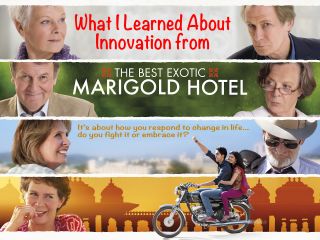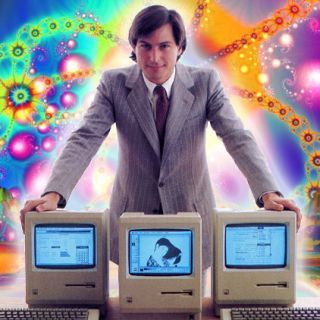Creativity
Innovation and The Best Exotic Marigold Hotel
A metaphor about staying agile, open to change, and innovative.
Posted August 15, 2013

Last year’s film The Best Exotic Marigold Hotel is not only an entertaining story about aging and resilience, it also expresses a very useful metaphor that informs us about how to keep our companies agile, open to change, and innovative. This affectionately told comedy is quite clever – a group of down-on-their-finances English retirees decide to leave behind their bleak British futures and move to a glamorous retirement hotel in Jaipur, India that promises to make their final years truly golden, and all for a fraction of the price of remaining at home.
However, when they arrive in India instead of the palatial resort they saw in the (heavily) photoshopped brochures, they find a crumbling, dusty excuse for a hotel, and they are distraught to be met by an eager, young go-getter whose dream of outsourcing retirement is decidedly beyond his capacity. The whole establishment is filled with good intentions but rife with mismanagement.
The film is composed of rich characters, well-meaning humor, and fine acting, and confronts important questions about life, meaning and mortality in a deeply moving yet genuinely hilarious way. For example, Douglas and Jean Ainslie (played by Bill Nighy and Penelope Wilton) are a quarrelsome couple who’ve lost their life savings and fall prey to the photoshopped brochures. Faced with the change, Jean simply refuses to leave the hotel after they arrive, and is vociferous in her rejection of all things Indian. Meanwhile, her husband joyfully explores the beauty of nearby temples and the local cuisine, as they head toward an inescapable explosion.

Each of our stars react to change in a different way – Graham Dashwood plays a retired High Court judge, who grew up in Jaipur and is returning there for the first time since his youth. His approach was one of despair – but a tone of despair as soft and suffocating as a pillow. He hopelessly begs the Indian bureaucracy to help him reconnect with his long lost gay Indian lover, whose family was disgraced when their affair was discovered. Maggie Smith plays an unqualified termagant in need of a hip replacement, who is bitterly yet comically xenophobic, and reacts to change with anger. The tale’s narrator, Judi Dench, is a recent widow forced to sell her home after learning that her husband squandered their nest egg. Evelyn embodies acceptance and serves as the spine of the story.
In fact, each of the characters illustrate Elisabeth Kubler-Ross’s stages of grief model. Although there is discussion about the clinical validity of the Kubler-Ross model of stages of grief, it's still useful nonetheless. The movie presents a jumble of characters who individually illustrate denial, anger, bargaining, and sorrow, and eventually, the characters one by one move toward acceptance (or what we call “re-birth”, and it usually comes in waves of acceptance instead of through sequential stages)... which finally leads to the capacity for a new life. And so, at the heart of the film, is a message about a most important choice in life, whether to expand and grow, or to wither and die.
Hidden within the film is also a map for revitalizing your company, as these stages can also reflect the development of an organization in the face of increasing competition and challenging market dynamics. For example, when the Internet arrived as a force in business, what was your organization’s response? Was it denial, anger, bargaining, and sorrow… or did you jump into the new opportunities with glee? When globalization started putting pressure on your pricing model, did you fight it with cost cutting and austerity, or did you strike out and find new business models?
Let’s look at a few companies and how the stages of grief model is reflected in the stories of their arrivals at the challenges of change…
The US Postal Service – Denial
The United States Postal Service was created in 1775 to provide the American public with trusted universal postal service at affordable prices. Despite the telephone, the fax machine, the internet, texting, and electronic mail, the USPS has continued clinging to its original mission, penned at the end of the 18th century. Its revenues have dropped faster than its ability to shed employees, and its main mission seems to be delivering bills and junk mail.
The lesson from the USPS’s reaction to change – denial – is that no matter how noble your original mission, you must remain both responsive and agile to changes in the market, especially during periods of massive change such as today. Further, in these times of change, every business needs its own laboratory to study and experiment with the future so that change does not overwhelm your existing revenue streams and business model.
Blockbuster Video - Bargaining
Blockbuster, a long time giant in the brick-and-mortar video rental industry, began losing favor when new business models emerged. In particular, Netflix was particularly agile when it came to online streaming. Blockbuster leaders believed that their customers would remain loyal, but when they finally understood that customers were leaving they attempted to bargain with their customers by adding a by-mail online service similar to the one Netflix started with. This was not enough to affect the flow of customers, and by the time they realized how far ahead their competition was in terms of convenience, pricing, and even fees, it was too late to transform its business model for the digital world quickly enough. Even a $228 million buyout by Dish Network could not save the day.
Blockbuster ultimately failed because it could not sense shifts in customer demand, and instead focused on short-term gains. It stuck with what had worked in the past, and assumed customers would stick around. When it was too late, the approach of bargaining didn’t work … at all.
Apple Computer – Acceptance
The example of acceptance is well expressed in the character of Evelyn, who embodies the same spirit that companies must develop to survive the Information Revolution. Recently widowed in England, the movie begins as she struggles to deal with her late husband’s affairs, and grapples with new difficulties and complications. Once in India, her can-do spirit is exhibited by her willingness to take a job at an Indian call center, which she does as a source of both satisfaction and much needed income, and then immerses herself in the beauty of India, and in the end, renews herself by finding love again.

Apple’s turnaround from the decline of the John Sculley era shows a distinct similarity to Evelyn’s story. When Steve Jobs returned, the company was close to bankruptcy and Jobs was forced by dire circumstances to enter a humiliating agreement with Bill Gates to raise $150 million to keep the company afloat. Despite these challenges, at the nadir of Apple’s fortunes Jobs remained focused on his role as a creative leader, at one point berating its board, “The cure for Apple is not cost-cutting. The cure for Apple is to innovate its way out of its current predicament.” Like Evelyn’s characters shows, that optimistic spirit and the talent to execute remains at the heart of Apple’s ability to create innovations.
It’s said that adversity causes some men to break, but others to break records. The same can be said about companies. Where does your company stand when the chips are down?
The Vital Role of Visionary
One more analogy from the film is instructive to consider. The manager of the hotel is played by Dev Patel from Slumdog Millionaire, whose ebullient optimism is so adorable that it’s hard to believe that things won't eventually turn out just fine. This young man is filled with vision, but weak on implementation, and shows many of the key characteristics of chief innovation officers whose companies are confronted with change. The realities of change are often hard to grasp and harder to accept, and the road to transformation is sometimes painful and perilous. And yet effective leaders know that the old and familiar must be released (usually with some pain), and the new must be welcomed (usually with some apprehension), and in this task both innovation officers and strategic consultants can sometimes help a great deal.
These rare managers and consultants must often provide "photoshopped visions" of what your company could someday become, in order to convince management to become more innovative. Even though such visions may be unrealistic, such people are absolutely needed to hold the space for vision – and in this capacity, act as the shamans who can enable the sixth stage of the Kubler-Ross’s model: effective action that leads to rebirth.
The story of the film requires a visionary to encourage a group of retirees to start anew, just as a chief innovation officer or a special consultant can help your company find what it takes to make that transition to a new life and new world.
But the catalyzing step is to take action. This is not a small thing, as it requires finding the courage to “innovate your way out of the predicament” - which, in desperate times, feels a bit like building a parachute on the way down. It’s a far more courageous choice than the kneejerk reaction of laying off some staff and battening down the hatches. It is a commitment to boldness that breathes life into a vision of change.
Note: This is an excerpt from a monograph that I’m writing with Claire Rumore, my associate in my innovation consulting practice, which is titled “All I Really Need to Know about Innovation, I Learned from the Movies”. If these musings are compelling to you, please let us know in the comment stream, and we’ll post additional excerpts. Thanks!




